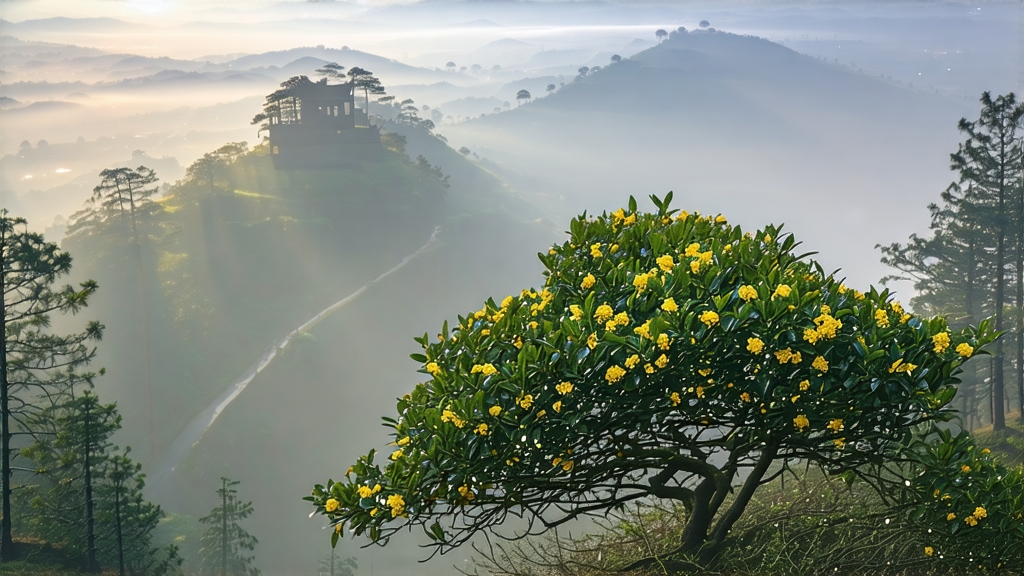
High on Mengding Mountain, where Sichuan’s clouds brush the shoulders of 1,450-metre peaks, a tea once reserved for emperors still unfurls its velvet buds each early April. Mengding Huangya—literally “Yellow Bud of Mengding”—is the oldest documented yellow tea in China, yet the least known outside its native mist. While green tea commands the world’s attention and pu-erh fills collectors’ vaults, this golden-hued rarity lingers in a quiet niche, protected by altitude, nostalgia, and a manufacturing secret known as “sealed yellowing.” To meet it is to step into a Song-dynasty scroll where tea was medicine, poetry, and diplomacy in one tiny, downy tip.
History: from altar to emperor
Buddhist monk Wu Lizhen planted seven tea bushes on Mengding in 53 BCE, ostensibly for temple offerings; by Tang times those bushes were dubbed “immortal tea,” and in 724 CE the court of Xuanzong declared Mengding tea the sole tribute of Sichuan. When Song emperor Huizong—himself a skilled tea aesthete—sampled an early-spring batch whose liquor glowed like topaz, he renamed the cultivar Huangya and restricted it to the palace. For eight dynasties the tea reached Beijing via bamboo-lined chests carried by fast horses along the old Shu Road, arriving while the buds were still fragrant with mountain orchids. After 1911 the imperial order collapsed, and Mengding Huangya retreated into local monasteries; only in 1959 did the Sichuan government revive the craft for state banquets, and in 2008 it was listed as a China National Intangible Cultural Heritage.
Micro-terroir: where cloud root meets yellow soil
Mengding benefits from what locals call “three clouds a day”: morning mist, afternoon fog, and evening low clouds that act like a silk curtain against UV burn. The mountain’s yellow sandy loam is rich in selenium and zinc, while diurnal swings of 10–15 °C slow polyphenol oxidation, allowing amino acids—especially L-theanine—to accumulate. The result is a bud that weighs only 0.12 g yet contains 5.8 % theanine, double that of平地 green teas, giving the liquor its signature brothy sweetness.
Plucking: one bud, no leaf, no rain
The picking window opens when the mountain azalea blooms, usually between 20 March and 5 April. Only the unopened bud, shaped like a grain of rice with a faint hook, is taken. Pickers work before 09:00, while dew still acts as a natural preservative. A skilled woman can gather 600 g fresh buds in a morning; 6 kg of buds are required to finish 1 kg of dry tea, explaining why Mengding Huangya retails above USD 1,200 per kilogram.
Craft: the invisible 48-hour sweat
Yellow tea’s defining step is “sealed yellowing,” a controlled post-oxidation that occurs twice in Mengding Huangya. First, the freshly killed-green buds are wrapped in thin cotton cloth while still 60 °C hot; enzymes convert residual chlorophyll into pheophytin, shifting colour from jade to lemon. After 24 hours the cloth is opened, leaves are gently hand-rubbed for 20 minutes to re-align cell walls, then re-wrapped for a second 24-hour yellowing at 35 °C and 75 % humidity. Throughout, the tea master listens: when the rustle of buds softens to a whisper like silk, the process is complete. Finally the buds are charcoal-baked over three nights at descending temperatures (80 °C, 60 °C, 40 °C) to lock in the honeyed aroma. Total processing time: 72 labour-intensive hours versus the 4-hour cycle of most green teas.
Grades & styles
1) Imperial Needle (特级黄芽): buds 15–20 mm, downy silver, liquor the colour of chardonnay with a sustained orchid finish.
2) Altar Tribute (贡品黄芽): slightly longer buds, 20–25 mm, more chestnutty note, traditionally offered at the Mengding Taoist altar during Qingming.
3) Misty Pearl (蒙顶松黄): buds gently rolled into loose spirals, invented in 1998 for easier overseas shipping, yet still undergoes full yellowing